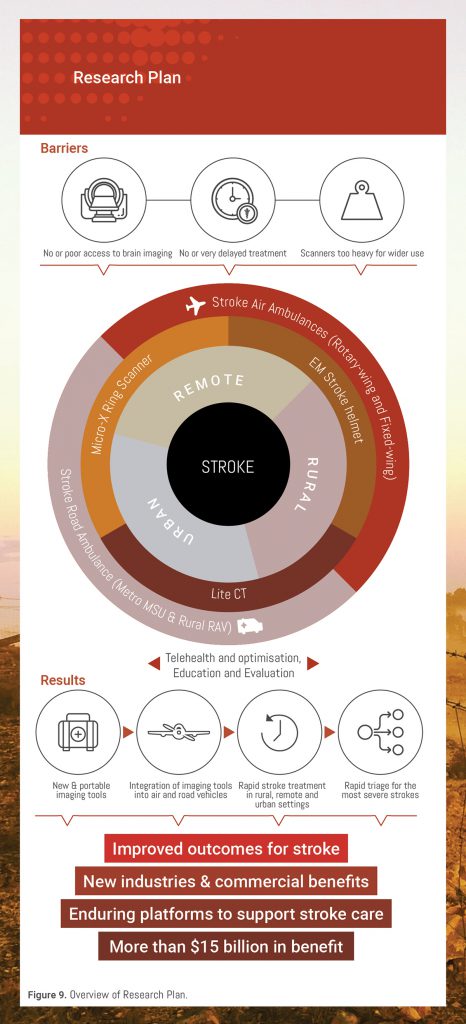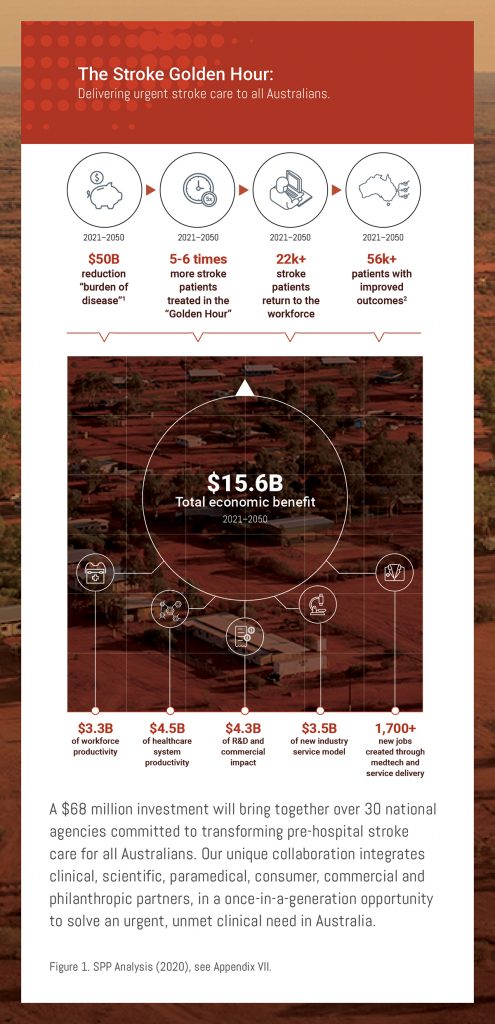The Plan
Take off
Our national alliance is committed to build on the successes of the nation’s first mobile stroke ambulance in Melbourne. We are strapping in to bring the Stroke Golden Hour to Australia’s roads and skies.
Working with partners like the Royal Flying Doctors Service, Ambulance Victoria and engineers from RMIT University, we aim to integrate novel brain imaging devices into emergency planes and helicopters thereby developing the world’s first air stroke ambulances.
The design of ultra-lightweight and low-cost brain imaging devices is progressing well as we prepare to provide essential images of patients’ brains at the scene of the stroke.
Regardless of geographical location, brain images will be sent immediately to city-based stroke physicians who will diagnose the type of stroke that has occurred – within minutes. This overcomes a major gap in care as stroke physicians are rarely located in rural hospital settings.
It would truly be such a game changer for Central Australian stroke management. Our catchment area is huge (>1,000,000 km2) – from Elliot in the north, down to near Coober Pedy in the South, over into the Western desert regions of WA and over the border of Queensland… making distance and time major issues for timely stroke management.
Our research plan
Our national team is immersed in the quest to overcome a massive global problem – slow stroke treatment times – and to address an enormous unmet clinical need.
We know stroke is the second most common cause of death globally and a leading cause of disability. In Australia, there are about 38,000 stroke events annually, or more than 100 a day, according to the Australian Institute of Health and Welfare. The Stroke Foundation’s data from Deloitte Access Economics tells us that 27,428 Australians will experience their first stroke in a 12-month period. Unfortunately, many survivors of a first stroke will have another, especially if prevention medication is not taken and recommended lifestyle changes are not maintained.
There are an estimated 445,000 stroke survivors living in Australia, the majority with a disability that impacts their everyday life. Today, someone in Australia suffers a new stroke every 19 minutes, according to the Stroke Foundation. By 2050 this will almost double to every 10 minutes, and new data tells us there will be 819,900 Australian stroke survivors.
As well as saving lives, our research will deliver new imaging technologies, digital telehealth across the nation, education programs and thousands of jobs in medical technology industries.

Impact
The chain of survival for stroke begins with early access to brain imaging to help health practitioners to accurately diagnose and then treat.
Rapid therapy after sophisticated brain scanning impacts lives and reduces lifelong disability. We know that these treatments work. Now is the time to make them available for all Australians.
The outcomes of our collective research effort will deliver:
- Brain scanners developed for the mobile setting and integrated into air and road ambulances that are tested and validated in the marketplace and clinical settings.
- A validated model of pre-hospital stroke care to enhance capacity and capability for translational research within Australia’s health and medical research sector.
- Commercial returns to ensure the sustainability of the Australian Stroke Alliance. This will enable reinvestment in future technologies, to be developed and built in Australia.
We are ready to offer the right stroke care at the right time, no matter where someone lives.

It is through collaborations with consumers that we are reminded of the potential for us to make a difference. We often refer to DALYs – disability adjusted life years – a term used widely by the research community to assess the impact of our interventions.
The Australian Stroke Alliance has calculated that some 45,000 DALYs will be saved over 30 years through our interventions.